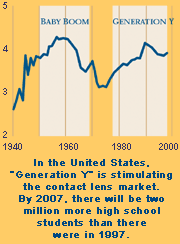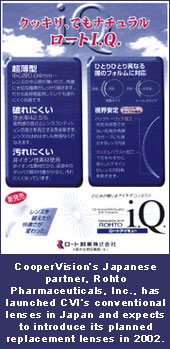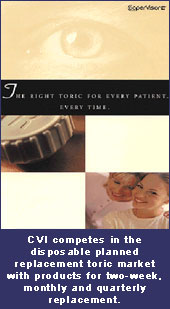|
In fiscal year 2000, The Cooper Companies continued to generate strong
increases in revenue, earnings and cash flow. Since 1995, the first full
year under the current management, Cooper's revenue has grown at a compounded
annual rate of 29 percent, its operating income at 46 percent, its pro
forma earnings per share from continuing operations at 45 percent and
its cash flow per share at 38 percent.
During this period, both of our medical device business units have prospered.
CooperVision (CVI), our contact lens business, has grown its revenue at
a compounded annual rate of 29 percent and today is one of the world's
leading and fastest growing manufacturers of contact lenses.
CooperSurgical (CSI), our women's healthcare business, has achieved significant
scale, with revenue growing at a compounded annual rate of 29 percent
and now approaching $50 million annually, as we continue to consolidate
a fragmented market. During this period, CSI has become a major manufacturer
and marketer of medical device products for the gynecology segment of
the women's healthcare market in the United States and, we believe, the
largest supplier of gynecology devices for the physician's office.
Other measures of financial performance are equally strong. Over the past
five years:
• Cash flow (pretax income from continuing operations plus depreciation
and amortization) per share has grown from $.69 to $3.51.
• Debt has declined to 20 percent of total capitalization.
• One hundred shares of Cooper stock that cost $588 on October 31, 1995
increased in value by over 500 percent to $3,575 by the end of fiscal
2000. During this period the Company's market capitalization grew from
$68 million to $517 million.
We are proud of this record of consistent growth that Cooper's employees
have delivered and thank them for their continued commitment to our goals.
As we look ahead, we see positive market dynamics driven by favorable
demographics for both businesses and continued efficiency and innovation
in serving them.
 The soft
contact lens market around the world remains attractive, growing
at about six percent to an estimated $3 billion in 2000. In the United
States and in other industrialized countries, a new group of teenagers
is entering the market. As contact lens wear begins in the pre- and early
teen years, these new wearers are now beginning to generate a revenue
annuity. The soft
contact lens market around the world remains attractive, growing
at about six percent to an estimated $3 billion in 2000. In the United
States and in other industrialized countries, a new group of teenagers
is entering the market. As contact lens wear begins in the pre- and early
teen years, these new wearers are now beginning to generate a revenue
annuity.
In Japan, the world's second largest contact lens market, practitioners
are rapidly shifting to disposable and planned replacement soft contact
lenses from hard gas permeable lenses.
 In addition to these positive macro market trends, many lens manufacturers
are now launching new specialty, value-added products that are upgrading
the value of the market. In many countries outside the United States,
contact lens fitters are finding that toric lenses both benefit patient
vision and enhance practice income, and the market is expanding. Toric
lenses, the fastest growing segment of the worldwide contact lens market,
are CooperVision's leading products.
In addition to these positive macro market trends, many lens manufacturers
are now launching new specialty, value-added products that are upgrading
the value of the market. In many countries outside the United States,
contact lens fitters are finding that toric lenses both benefit patient
vision and enhance practice income, and the market is expanding. Toric
lenses, the fastest growing segment of the worldwide contact lens market,
are CooperVision's leading products.
New aspheric lens designs that provide a crisper quality of vision and
improved acuity in low light conditions also have been well accepted.
CVI's Frequency Aspheric lens has become the worldwide leader in
this value added category. CVI also married its aspheric technology to
a new line of cosmetic lenses, Frequency Colors, and entered this
second fastest growing segment of the worldwide specialty lens market
during 2000.
Favorable demographic trends also drive our women's healthcare business.
Women of the "baby-boomer" generation are reaching the age when gynecology
procedures are performed most frequently, and CooperSurgical has, through
both acquisition and internal development, built an extensive product
line to support them. You'll read more about this below in a special section,
CooperSurgical: Consolidating Women's Healthcare for Profitable Growth,
that details the women's healthcare market and CooperSurgical's strategy.
We feel strongly that CooperSurgical is an important member of the Cooper
family, and this section describes why.
YEAR
IN REVIEW
The Cooper Companies reported sales of $197.3 million for the fiscal year,
a 19 percent increase over 1999. CVI's revenue grew to $151.8 million,
up 12 percent, while CSI's grew to $45.5 million, a 55 percent increase
that reflects primarily the acquisition of two lines of women's healthcare
products earlier in the fiscal year. Diluted earnings per share from continuing
operations grew 32 percent to $2.03. Cash flow per share reached $3.51,
up from $2.82 the previous year.
 COOPERVISION COOPERVISION
In the United States, the largest contact lens market in the world, CVI's
revenue grew 18 percent to $97.8 million, improving its market share by
about one share point.
Outside the United States, CVI's core revenue grew 18 percent at constant
currency rates as new product launches, particularly in Canada and in
Europe, brought fresh vigor to our operations abroad. With the recent
acquisition of distributors in Sweden and Spain, we now have CVI infrastructures
in five countries outside the United States.
In Japan, through its marketing partner Rohto Pharmaceuticals, Inc., a
leader in the Japanese consumer eye care market, CVI has so far introduced
only conventional lenses – those worn for about a year before replacement
– and revenue is limited. We expect Rohto to introduce CVI's line of frequently
replaced lenses to Japanese practitioners in 2002 following regulatory
approval.
Rohto is the fourth-largest company in Japan's drug, cosmetic and healthcare
products industry with 2000 revenue of about $515 million and about 640
employees. It is the leading "over-the-counter" eye drop manufacturer
in Japan and ranks second or third in sales of contact lens solutions.
Rohto will use its significant distribution presence to market CVI's contact
lenses.
Rohto received Japanese regulatory approval in 1999 to sell CVI's conventional
spherical and toric lenses and has introduced these lenses under the Rohto
i.Q brand in Japan.
 Toric lenses to correct astigmatism continue to be CVI's strongest product
line. The torics lens market, about $330 million worldwide, continues
to grow faster than any other segment of the contact lens market. In the
United States, where about three-quarters of these products are sold,
we estimate that the toric market grew 7 percent, compared with a flat
market for spherical lenses, which correct only near- and farsightedness. Toric lenses to correct astigmatism continue to be CVI's strongest product
line. The torics lens market, about $330 million worldwide, continues
to grow faster than any other segment of the contact lens market. In the
United States, where about three-quarters of these products are sold,
we estimate that the toric market grew 7 percent, compared with a flat
market for spherical lenses, which correct only near- and farsightedness.
Sales of CVI's toric products in the United States grew 19 percent in
fiscal 2000, six times faster than the total U.S. contact lens market,
and its share of the total toric lens market in the United States reached
31 percent, up more than two share points. CVI's disposable planned replacement
toric revenue, led by Frequency Toric and the new CV Encore
Toric, grew 32 percent. CVI now holds about 34 percent of this market.
CVI's gross margin improved from 66 percent of revenue to 69 percent
year to year due to a favorable product mix shift to higher margin products
and to continuing manufacturing efficiencies. As our sales to Rohto in
Japan become significant, we expect our gross margin to decline but operating
margins to remain at historic levels while we generate incremental operating
income from our Japanese sales. Under our agreement, Rohto will incur
the costs to market the lenses in Japan, and our prices to them will reflect
this arrangement. These lower prices will reduce our gross margins, but
without local marketing costs, our operating margins will remain intact.
CVI launched three important new specialty lens products during 2000.
In the first quarter, we launched Frequency Aspheric in the United
States following its overseas introduction in 1999. The optical properties
of this lens improve visual acuity in low light conditions and correct
low amounts of astigmatism where toric lenses are not indicated. This
offers practitioners the opportunity to improve patient vision while adding
incremental income to their practices with a value added, highly featured
product.

 In May,
CVI introduced Frequency Colors in Europe and in September,
launched Encore Colors in Canada. In the first quarter of 2001,
CVI will start marketing Frequency Colors in the United States.
The cosmetic lens market – opaque and color enhancing lenses that change
the appearance of the eye's natural color – is the second largest specialty
lens market segment behind toric lenses. Worldwide revenue is about $250
million, growing at about 8 percent annually. The Frequency Colors
line of five opaque colored lenses is well differentiated from its competition
in three important ways: In May,
CVI introduced Frequency Colors in Europe and in September,
launched Encore Colors in Canada. In the first quarter of 2001,
CVI will start marketing Frequency Colors in the United States.
The cosmetic lens market – opaque and color enhancing lenses that change
the appearance of the eye's natural color – is the second largest specialty
lens market segment behind toric lenses. Worldwide revenue is about $250
million, growing at about 8 percent annually. The Frequency Colors
line of five opaque colored lenses is well differentiated from its competition
in three important ways:
First, patients rated Frequency Colors equal or better in appearance
than the top-selling brand of disposable color contacts. The technology
used to color the lenses randomly places dashes of color throughout the
lens in varying tones and intensity to give the appearance of a natural
iris.
Second, Frequency Colors has demonstrated superior comfort in clinical trials
compared to the leading competitive products.
Third, it incorporates
the benefits of the aspheric design of Frequency Aspheric.
Importantly, CVI's line of colored lenses are interchangeable with the leading brands of disposable spherical lenses,
so practitioners will not have to refit current wearers who want to use colored lenses occasionally.
During 2000, CVI also introduced a cast molded toric lens, CV Encore
Toric, to compete in the two-week segment of the disposable toric
market in the United States. Because of the efficient UltraSync
manufacturing technology, this lens can be priced competitively.
CVI also introduced the Cooper Prosthetic Lens this year. Prosthetic
lenses are similar to opaque lenses, but are denser in color to mask corneal
scarring and other conditions that cause the eye to appear unattractive.
 CVI's bifocal lens remains in clinical trials with a marketing decision
expected during 2001. Results must be superior to competitive lens performance
after six months of wear or we will not introduce this product. CVI's bifocal lens remains in clinical trials with a marketing decision
expected during 2001. Results must be superior to competitive lens performance
after six months of wear or we will not introduce this product.
CVI expanded its presence on the World Wide Web during 2000 with a new
marketing initiative that informs consumers about its advanced technology
lenses and refers them to local contact lens practitioners who have registered
on the CVI site. A second feature allows practitioners to ship lenses
directly to their patients or order lenses directly for their own inventory.
The Website is www.coopervision.com.
COOPERSURGICAL
Two acquisitions helped drive CSI's 2000 revenue to $45.5 million, up
55 percent. In December 1999, CSI purchased a group of women's healthcare
products from BEI Medical Systems Company, Inc., including a well-known
uterine manipulator and other products for the gynecological surgery market.
In January 2000, CSI purchased Leisegang Medical, Inc, a leading global
designer and manufacturer of precision instruments for women's healthcare
including colposcopes, instruments to perform loop electrosurgical excision
procedures, hand-held gynecology instruments, disposable specula and cryosurgical
systems. Many of the products are disposable, including the Sani-Spec
line of plastic specula, its largest product group. CSI believes it is
now the world's leading manufacturer and marketer of colposcopy products
– instruments used to examine the cervix.
In another transaction announced in October 2000, CSI purchased MedaSonics,
Inc., which markets a line of compact, hand-held Doppler ultrasound systems
used in obstetrics and gynecology, cardiology and other medical specialties.
Fetal Dopplers detect fetal life and viability from as early as nine weeks
gestation and assess the rate and rhythm of the fetal heartbeat. Vascular
Dopplers locate and determine the status of blood vessels and measure
systolic blood pressure in infants, and patients with trauma or obesity.
During surgery, dopplers detect venous air embolism, evaluates direct
vessel and transcutaneous blood flow and measures systolic blood pressure.
In November, CSI announced an exclusive distribution agreement with Norland
Medical Systems, Inc. to distribute a line of bone measurement systems
used to evaluate osteoporosis, a condition that affects 22 million American
women, many of whom could benefit from early diagnosis through pharmaceutical
intervention.
These transactions continue CSI's market consolidation strategy, and
CSI now believes that it is the largest manufacturer and marketer of
products for the physician's office segment of the gynecology market.
CSI's target is to reach $100 million in revenue by 2003 or 2004.
 During fiscal 2000, CSI's operating income grew 45 percent. In fiscal
2001, we expect its operating margin to approach 20 percent as we complete
the integration of the recent acquisitions.
During fiscal 2000, CSI's operating income grew 45 percent. In fiscal
2001, we expect its operating margin to approach 20 percent as we complete
the integration of the recent acquisitions.
In January 2000, the FemExam pH and Amines TestCard System
– a rapid, economical point of care diagnostic test used to help determine
if a vaginal infection is bacterial or fungal – received reimbursement
codes and guidelines from the American Medical Association and the United
States Health Care Financing Administration.
Since then, it has shown strong growth, averaging 30 percent sequential
quarterly revenue growth in the past three quarters. The Cerveillance
Digital Colposcope line of advanced imaging and information processing
technologies used to examine and monitor cervical tissue generates about
$2.5 million in annual revenue.
NEXT YEAR'S
GOALS
We see the momentum of the past five years continuing in 2001. We expect
earnings per share from continuing operations in the range of $2.36 to
$2.42 with revenue increasing between 16 percent and 21 percent. Both
of our businesses will continue to benefit from favorable demographics.
At CooperVision, recently introduced contact lens products and geographic
expansion will drive incremental revenue, and we look forward to beginning,
late in the year, to compete aggressively in Japan, the world's second
largest market. At CooperSurgical, we will continue to pursue our strategy
to consolidate the gynecology segment of the women's healthcare market.
Thank you for your continued support.

Allan E. Rubenstein, M.D.
Chairman of the Board

A. Thomas Bender
President and Chief Executive Officer
January 24, 2001
|